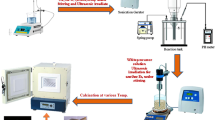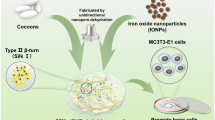Abstract
Changes in mineral texture (e.g. hydroxyapatite (HAP) or aragonite) and polypeptide (e.g. tropocollagen (TC)) residue sequence are characteristic features of a disease known as osteogenesis imperfecta (OI). In OI, different possibilities of changes in polypeptide residue sequence as well as changes in polypeptide helix replacement (e.g. 3 α1 chains instead of 2 α1 and 1 α2 chain in OI murine) exist. The cross section of the HAP crystals could be needle like or plate like. Such texture and residue sequence related changes can significantly affect the material strength at the nanoscale. In this work, a mechanistic understanding of such factors in determining strength of nanoscale TC–HAP biomaterials is presented using three dimensional molecular dynamics (MD) simulations. Analyses point out that the peak interfacial strength for failure is the highest for supercells with plate shaped HAP crystals. TC molecules with higher number of side chain functional groups impart higher strength to the TC–HAP biomaterials at the nanoscale. Overall, HAP crystal shape variation, the direction of applied loading with respect to the relative TC–HAP orientation, and the number of side chain functional groups in TC molecules are the factor that affect TC–HAP biomaterial strength in a significant manner.










Similar content being viewed by others
References
Fratzl P, Fratzlzelman N, Klaushofer K, Vogl G, Koller K. Nucleation and growth of mineral crystals in bone studied by small-angle X-ray scattering. Calcif Tissue Int. 1991;48(6):407–13.
Landis WJ, Hodgens KJ, Arena J, Song MJ, McEwen BF. Structural relations between collagen and mineral in bone as determined by high voltage electron microscopic tomography. Microsc Res Tech. 1996;33(2):192–202.
Landis WJ, Hodgens KJ, Song MJ, Arena J, Kiyonaga S, Marko M, et al. Mineralization of collagen may occur on fibril surfaces: evidence from conventional and high-voltage electron microscopy and three-dimensional imaging. J Struct Biol. 1996;117:24–35.
Weiner S, Talmon Y, Traub W. Electron diffraction of mollusc shell organic matrices and their relationship to the mineral phase. Int J Biol Macromol. 1983;5(6):325–8.
Dubey DK, Tomar V. Role of the nanoscale interfacial arrangement in mechanical strength of tropocollagen-hydroxyapatite based hard biomaterials. Acta Biomater. 2009. doi:10.1016/j.actbio.2009.02.035.
Dubey DK, Tomar V. Understanding the influence of structural hierarchy and its coupling with chemical environment on the strength of idealized tropocollagen-hydroxyapatite biomaterials. J Mech Phys Solids. 2009. doi:10.1016/j.jmps.2009.07.002.
Dubey DK, Tomar V. Effect of tensile and compressive loading on hierarchical strength of idealized tropocollagen-hydroxyapatite biomaterials as a function of chemical environment. J Phys Condens Matter. 2009;21:205103 (13 pp).
Fratzl P, Paris O, Klaushofer K, Landis WJ. Bone mineralization in an osteogenesis imperfecta mouse model studied by small-angle X-ray scattering. J Clin Invest. 1996;97:396–402.
Grabner B, Landis WJ, Roschger P, Rinnerthaler S, Peterlik H, Klaushofer K, et al. Age- and genotype-dependence of bone material properties in the osteogenesis imperfecta murine model (oim). Bone. 2001;29:453–7.
Khillian J, Olsen A, Kontusaari S, Sokolov B, Prockop D. Transgenic mice expressing the human gene for type I procollagen develop a phenotype resembling osteogenesis imperfecta. J Biol Chem. 1991;226(34):23373–9.
McBride DJ Jr, Choe V, Shapiro JR, Brodsky B. Altered collagen structure in mouse tail tendon lacking the alpha 2(I) chain. J Mol Biol. 1997;270:275–84.
Sarathchandra P, Pope FM. Unexpected ultrastructral changes in bone osteiod collagens in osteogenesis imperfecta. Micron. 2005;36:696–702.
Rauch F, Glorieux FH. Osteogenesis imperfecta. Lancet. 2004;363:1377–85.
Bonucci E. Basic composition and structure of bone. In: An YH, Draughn RA, editors. Mechanical testing of bone and the bone–implant interface. Boca Raton: CRC Press; 2000, p. 3–21.
Currey JD. Bones: structure and mechanics. 2nd ed. Princeton, NJ: Princeton University Press; 2002.
Matsushima N, Akiyama M, Terayama Y. Quantitative-analysis of the orientation of mineral in bone from small-angle X-ray-scattering patterns. Jpn J Appl Phys I. 1982;21(1):186–9.
Buehler MJ. Nanomechanics of collagen fibrils under varying cross-link densities: Atomistic and continuum studies. J Mech Behav Biomed Mater. 2008;1:59–67.
Fan Z, Smith PA, Harris GF, Rauch F, Bajorunaite R. Comparison of nanoindentation measurements between osteogenesis imperfecta Type III and Type IV and between different anatomic locations (femur/tibia versus iliac crest). Connect Tissue Res. 2007;48:70–5.
Ji B, Gao H. Mechanical properties of nanostructure of biological materials. J Mech Phys Solids. 2004;52:1963–90.
Habelitz S, Marshall SJ, Marshall GW, Balooch M. Mechanical properties of human dental enamel on the nanometre scale. Arch Oral Biol. 2001;46(2):173–83.
Rodriguez-Navarro AB, CabraldeMelo C, Batista N, Morimoto N, Alvarez-Lloret P, Ortega-Huertas M, et al. Microstructure and crystallographic-texture of giant barnacle (Austromegabalanus psittacus) shell. J Struct Biol. 2006;156(2):355–62.
Eppell SJ, Smith BN, Kahn H, Ballarini R. Nano measurements with micro-devices: mechanical properties of hydrated collagen fibrils. J R Soc Interface. 2005;3:117–21.
Gupta HS, Wagermaier W, Zickler GA, Aroush DR-B, Funari SS, Roschger P, et al. Nanoscale deformation mechanisms in bone. Nano Lett. 2005;5(10):2108–11.
Gupta HS, Wagermaier W, Zickler GA, Hartmann J, Funari SS, Roschger P, et al. Fibrillar level fracture in bone beyond the yield point. Int J Fract. 2006;139(3–4):425–36.
Sasaki N, Odajima S. Elongation mechanism of collagen fibrils and force-strain relations of tendon at each level of structural hierarchy. J Biomech. 1996;29:1131–6.
Sasaki N, Odajima S. Stress–strain curve and Young’s modulus of a collagen molecule as determined by the X-ray diffraction technique. J Biomech. 1996;29(5):655–8.
Fantner GE, Hassenkam T, Kindt JH, Weaver JC, Birkedal H, Pechenik L, et al. Sacrificial bonds and hidden length dissipate energy as mineralized fibrils separate during bone fracture. Nat Mater. 2005;4(8):612–6.
Hodge AJ, Petruska JA. Recent studies with the electron microscope on ordered aggregates of the tropocollagen macromolecule. In: Ramachandran GN, editor. Aspects of protein structure. Proceedings of a symposium; 1963. p. 289–300.
Thurner PJ, Erickson B, Jungmann R, Schriock Z, Weaver JC, Fantner GE, et al. High-speed photography of compressed human trabecular bone correlates whitening to microscopic damage. Eng. Fract. Mech.. 2007;74:1928–41.
Gao H. Application of fracture mechanics concepts to hierarchical biomechanics of bone and bone-like materials. Int J Fract. 2006;138:101–37.
Jager I, Fratzl P. Mineralized collagen fibrils: a mechanical model with a staggered arrangement of mineral particles. Biophys J. 2000;79(4):1737–46.
Ji BH. A study of the interface strength between protein and mineral in biological materials. J Biomech. 2008;41(2):259–66.
Buehler MJ. Naure designs tough collagen: explaining the nanostructure of collagen fibrils. Proce Natl Acad Sci USA (PNAS). 2006;103:12285–300.
Lorenzo AC, Caffarena ERl. Elastic properties, Young’s modulus determination and structural stability of the tropocollagen molecule: a computational study by steered molecular dynamics. J Biomech. 2005;38:1527–33.
Israelowitz M, Rizvi SWH, Kramer J, von Schroeder HP. Computational modeling of type I collagen fibers to determine the extracellular matrix structure of connective tissues. Protein Eng Des Sel. 2005;18(7):329–35.
Handgraaf J-W, Zerbetto F. Molecular dynamics study of onset of water gelatin around the collagen triple helix. Proteins Struct Funct Bioinform. 2006;64:711–8.
Zhang D, Chippada U, Jordan K. Effect of the structural water on the mechanical properties of collagen-like microfibrils: a molecular dynamics study. Ann Biomed Eng. 2007;35:1216–30.
Radmer RJ, Klein TE. Triple helical structure and stabilization of collagen-like molecules with 4(R)-hydroxyproline in the Xaa position. Biophys J. 2006;90:578–88.
Buehler MJ. Atomistic and continuum modeling of mechanical properties of collagen: elasticity, fracture, and self-assemly. J Mater Res. 2006;21(8):1947–62.
Vesentini S, Fitie CFC, Montevecchi FM, Redaelli A. Molecular assessment of the elastic properties of collagen-like homotrimer sequences. Biomech Model Mechanobiol. 2005;3(4):224–34.
Phillips JC, Braun R, Wang W, Gumbart J, Tajkhorshid E, Villa E, et al. Scalable molecular dynamics with NAMD. J Comput Chem. 2005;26:1781–802.
Bella J, Eaton M, Brodsky B, Berman HM. Crystal and molecular structure of a collagen-like peptide at 1.9 angstrom resolution. Science. 1994;266:75–81.
Klein TE, Huang CC. Computational investigations of structural changes resulting from point mutations in a collagen-like peptide. Biopolymers. 1999;49(2):167–83.
Kramer RZ, Venugopal MG, Bella J, Mayville P, Brodsky B, Berman HM. Staggered molecular packing in crystals of a collagen-like peptide with a single charged pair. J Mol Biol. 2000;301(5):1191–205.
Orgel J, Irving TC, Miller A, Wess TJ. Microfibrillar structure of type I collagen in situ. Proc Natl Acad Sci USA. 2006;103(24):9001–5.
Huang CC, Couch GS, Pettersen EF, Ferrin TE. The object technology framework (OTF): an object-oriented interface to molecular data and its application to collagen. In: Pacific symposium on biocomputing; 1998. p. 349–60.
Elliott JC, Mackie PE, Young RA. Monoclinic hydroxyapetite. Science. 1973;8:1055–7.
Ponder JW, Case DA. Force fields for protein simulations. In: Protein simulations. San Diego: Academic Press Inc; 2003. p. 27.
Bhowmik R, Katti KS, Katti D. Molecular dynamics simulation of hydroxyapatite-polyacrylic acid interface. Polymer. 2007;48:664–74.
Hauptmann S, Dufner H, Brickmann J, Kast SM, Berry RS. Potential energy function for apatites. Phys Chem Chem Phys. 2003;5(3):635–9.
Jorgensen WL, Chandrasekhar J, Madura JD, Impey RW, Klein ML. Comparison of simple potential functions for simulating liquid water. J Chem Phys. 1983;79(2):926–35.
Anderson D. Collagen self-assembly: a complementary experimental and theoretical perspective. PhD dissertation, University of Toronto; 2005.
Biltz RM, Pellegri ED. Chemical anatomy of bone. I. A comparative study of bone composition in 16 vertebrates. J Bone Joint Surg Am. 1969;A51(3):456
Mueller KH, Trias A, Ray RD. Bone density and composition—age-related and pathological changes in water and mineral content. J Bone Joint Surg Am. 1966;A48(1):140.
Weiner S, Wagner HD. The material bone: structure mechanical function relations. Annu Rev Mater Sci. 1998;28:271–98.
Sasaki N, Enyo A. Viscoelastic properties of bone as a function of water-content. J Biomech. 1995;28(7):809–15.
Timmins PA, Wall JC. Bone water. Calcif Tissue Res. 1977;23(1):1–5.
Tomar V, Zhou M. Analyses of tensile deformation of nanocrystalline α-Fe2O3 + fcc-Al composites using classical molecular dynamics. J Mech Phys Solids. 2007;55:1053–85.
Zhou M. A new look at the atomic level virial stress—on continuum-molecular system equivalence. Proc R Soc Lond A. 2003;459:2347–92.
Dong XN, Guo XE. The dependence of transversely isotropic elasticity of human femoral cortical bone on porosity. J Biomech. 2004;37(8):1281–7.
Wirtz DC, Schiffers N, Pandorf T, Radermacher K, Weichert D, Forst R. Critical evaluation of known bone material properties to realize anisotropic FE-simulation of the proximal femur. J Biomech. 2000;33(10):1325–30.
Radmer RJ, Klein TE. Severity of osteogenesis imperfecta and structure of a collagen-like peptide modeling a lethal mutation site. Biochemistry. 2004;43(18):5314–23.
Posner AS, Beebe RA. The surface chemistry of bone mineral and related calcium phosphates. Semin Arthritis Rheum. 1975;4(3):267–91.
Berryman JG. Bounds and self-consistent estimates for elastic constants of random polycrystals with hexagonal, trigonal, and tetragonal symmetries. J Mech Phys Solids. 2005;53(10):2141–73.
Persikov AV, Ramshaw JAM, Brodsky B. Prediction of collagen stability from amino acid sequence. J Biol Chem. 2005;280(19):19343–9.
Author information
Authors and Affiliations
Corresponding author
Rights and permissions
About this article
Cite this article
Dubey, D.K., Tomar, V. Effect of changes in tropocollagen residue sequence and hydroxyapatite mineral texture on the strength of ideal nanoscale tropocollagen-hydroxyapatite biomaterials. J Mater Sci: Mater Med 21, 161–171 (2010). https://doi.org/10.1007/s10856-009-3837-7
Received:
Accepted:
Published:
Issue Date:
DOI: https://doi.org/10.1007/s10856-009-3837-7




